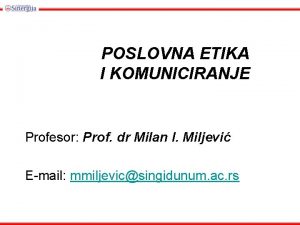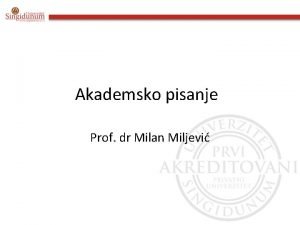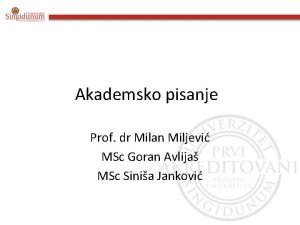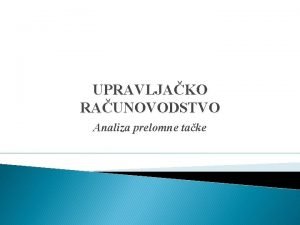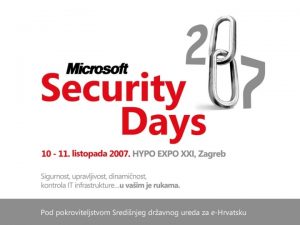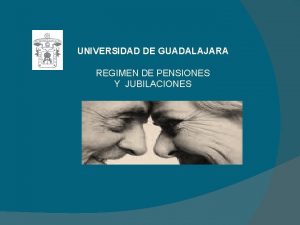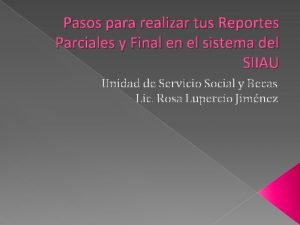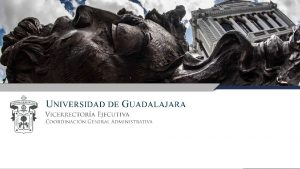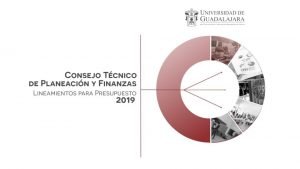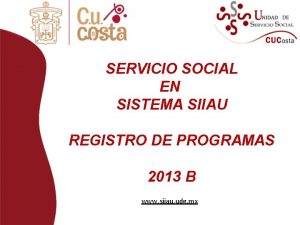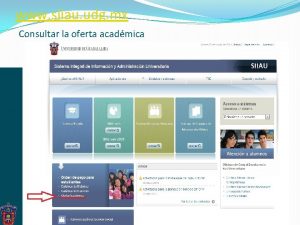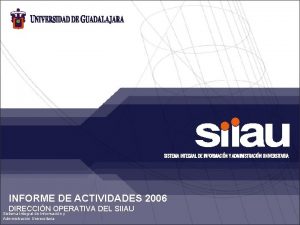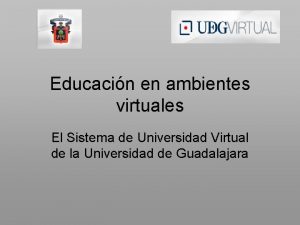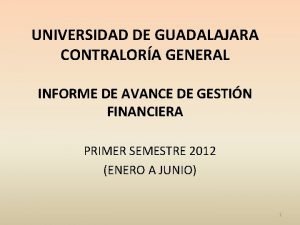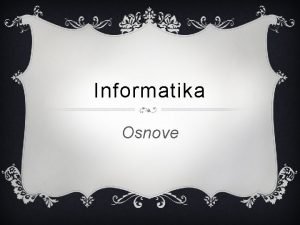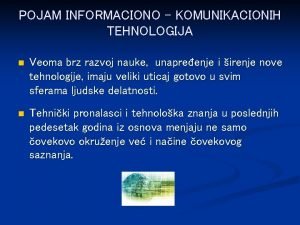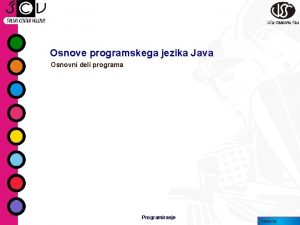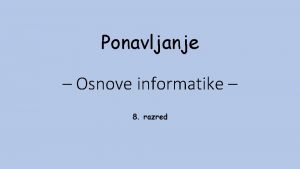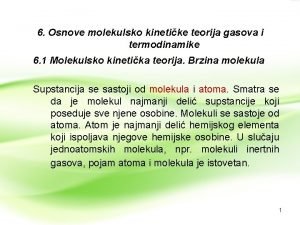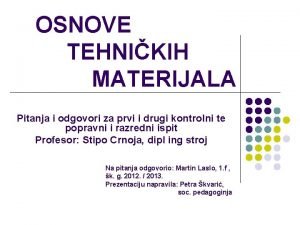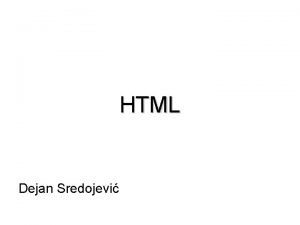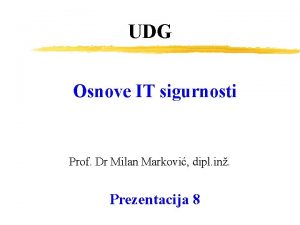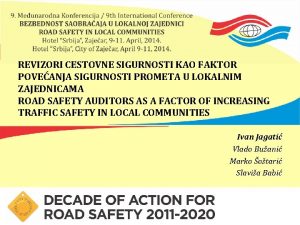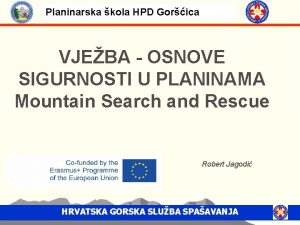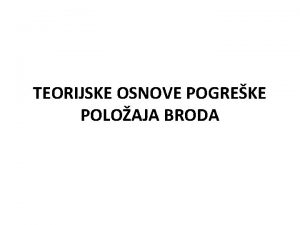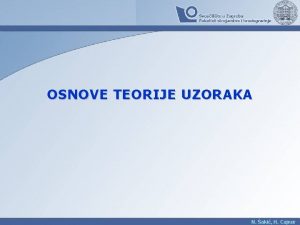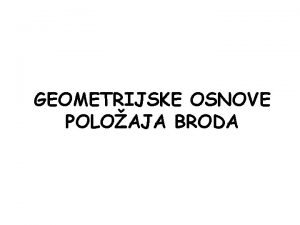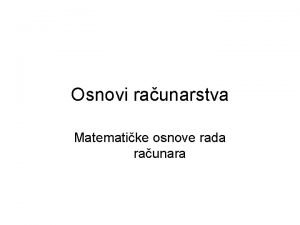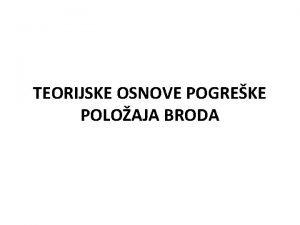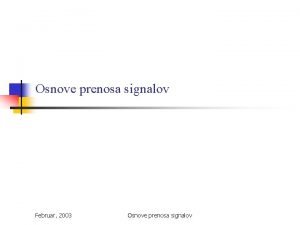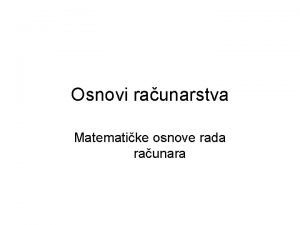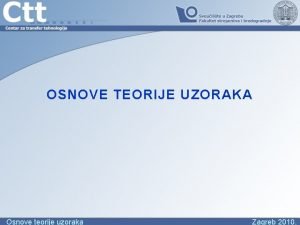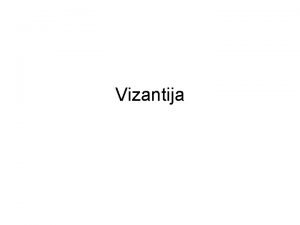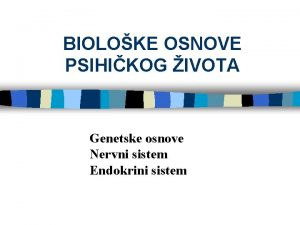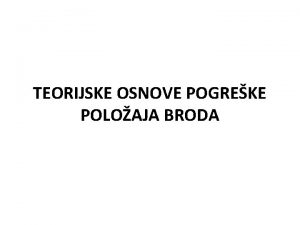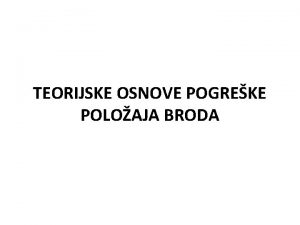UDG Osnove IT sigurnosti Prof Dr Milan Markovi










































- Slides: 42

UDG Osnove IT sigurnosti Prof. Dr Milan Marković, dipl. inž. Prezentacija 6



Need for authentication Us er' sp rof ile Controlled access to data Per son Server al i Client nfo r ma ti on. . .

Client and server authentication Bob Server 1 Alice Server 2

Заштита Web приступа ? HTTP Client HTTP Server

Заштићени комуникациони канал Client Internet Extranet Intranet Server

Secure Socket Layer = SSL / TLS § TLS = latest version of SSL issued by the IETF § Provides a secure tunnel to § convey information § enable client / server mutual authentication § ensure tamper detection § Implemented in servers most existing Web browsers and

Испод апликативног нивоа. . . Application HTTP FTP POP 3 SMTP IMAP TELNET SSL Network TCP/IP NNTP. . .

SSL протокол § Две фазе: § Аутентикација. . . § Заштићена комуникација Client Handshaking Authentication Session Key Exchange Data exchange Encryption / Signature Server

SSL standard § SSL 3 § Designed to make its security services as transparent as possible to the end user § De-facto industry standard originating from Netscape § Public key, cross authentication § Over 100000 web sites using SSL today

SSL features § A comprehensives security protocol that offers the choice of algorithms for: § § Authentication (RSA, DSA, none. . . ) Session key establishment (RSA, Diffie-Hellman, none) Data signature (MD 5, SHA-1, none) Data encryption (DES, DES 3, RC 4, RC 2, IDEA, none) § The choice of algorithms is negociated between client and server. Almost all features are optional

Introduction § § This document introduces the Secure Sockets Layer (SSL) protocol. Originally developed by Netscape, SSL has been universally accepted on the World Wide Web for authenticated and encrypted communication between clients and servers. The new Internet Engineering Task Force (IETF) standard called Transport Layer Security (TLS) is based on SSL. This was recently published as an IETF Internet. Draft, The TLS Protocol Version 1. 0.

SSL protocol § § The Transmission Control Protocol/Internet Protocol (TCP/IP) governs the transport and routing of data over the Internet. Other protocols, such as the Hyper. Text Transport Protocol (HTTP), Lightweight Directory Access Protocol (LDAP), or Internet Messaging Access Protocol (IMAP), run "on top of" TCP/IP in the sense that they all use TCP/IP to support typical application tasks such as displaying web pages or running email servers. The SSL protocol runs above TCP/IP and below higherlevel protocols such as HTTP or IMAP. It uses TCP/IP on behalf of the higher-level protocols, and in the process allows an SSL-enabled server to authenticate itself to an SSL-enabled client, allows the client to authenticate itself to the server, and allows both machines to establish an encrypted connection.

SSL protocol

SSL protocol § These capabilities address fundamental concerns about communication over the Internet and other TCP/IP networks: § § § SSL server authentication allows a user to confirm a server's identity. SSL client authentication allows a server to confirm a user's identity. An encrypted SSL connection requires all information sent between a client and a server to be encrypted by the sending software and decrypted by the receiving software, thus providing a high degree of confidentiality.

SSL protocol § These capabilities address fundamental concerns about communication over the Internet and other TCP/IP networks: § § § SSL server authentication allows a user to confirm a server's identity. SSL client authentication allows a server to confirm a user's identity. An encrypted SSL connection requires all information sent between a client and a server to be encrypted by the sending software and decrypted by the receiving software, thus providing a high degree of confidentiality.

SSL protocol § The SSL protocol includes two sub-protocols: § § the SSL record protocol and the SSL handshake protocol. The SSL record protocol defines the format used to transmit data. The SSL handshake protocol involves using the SSL record protocol to exchange a series of messages between an SSL-enabled server and an SSL-enabled client when they first establish an SSL connection.

SSL protocol § This exchange of messages is designed to facilitate the following actions: § § § Authenticate the server to the client. Allow the client and server to select the cryptographic algorithms, or ciphers, that they both support. Optionally authenticate the client to the server. Use public-key encryption techniques to generate shared secrets. Establish an encrypted SSL connection.

Ciphers used with SSL § § § The SSL protocol supports the use of a variety of different cryptographic algorithms, or ciphers, for use in operations such as authenticating the server and client to each other, transmitting certificates, and establishing session keys. Clients and servers may support different cipher suites, or sets of ciphers, depending on factors such as the version of SSL they support, company policies regarding acceptable encryption strength, and government restrictions on export of SSL-enabled software. Among its other functions, the SSL handshake protocol determines how the server and client negotiate which cipher suites they will use to authenticate each other, to transmit certificates, and to establish session keys.

Ciphers used with SSL § § § § § DES. Data Encryption Standard, an encryption algorithm used by the U. S. Government. DSA. Digital Signature Algorithm, part of the digital authentication standard used by the U. S. Government. KEA. Key Exchange Algorithm, an algorithm used for key exchange by the U. S. Government. MD 5. Message Digest algorithm developed by Rivest. RC 2 and RC 4. Rivest encryption ciphers developed for RSA Data Security. RSA. A public-key algorithm for both encryption and authentication. Developed by Rivest, Shamir, and Adleman. RSA key exchange. A key-exchange algorithm for SSL based on the RSA algorithm. SHA-1. Secure Hash Algorithm, a hash function used by the U. S. Government. SKIPJACK. A classified symmetric-key algorithm implemented in FORTEZZA-compliant hardware used by the U. S. Government. (For more information, see FORTEZZA Cipher Suites. ) Triple-DES. DES applied three times.

Ciphers used with SSL § § § Key-exchange algorithms like KEA and RSA key exchange govern the way in which the server and client determine the symmetric keys they will both use during an SSL session. The most commonly used SSL cipher suites use RSA key exchange. The SSL 2. 0 and SSL 3. 0 protocols support overlapping sets of cipher suites. Administrators can enable or disable any of the supported cipher suites for both clients and servers. When a particular client and server exchange information during the SSL handshake, they identify the strongest enabled cipher suites they have in common and use those for the SSL session. Decisions about which cipher suites a particular organization decides to enable depend on trade-offs among the sensitivity of the data involved, the speed of the cipher, and the applicability of export rules.

Ciphers used with SSL § § § Some organizations may want to disable the weaker ciphers to prevent SSL connections with weaker encryption. To serve the largest possible range of users, it's administrators may wish to enable as broad a range of SSL cipher suites as possible. That way, when a domestic client or server is dealing with another domestic server or client, respectively, it will negotiate the use of the strongest ciphers available. And when an domestic client or server is dealing with an international server or client, it will negotiate the use of those ciphers that are permitted under U. S. export regulations. However, since 40 -bit ciphers can be broken relatively quickly, administrators who are concerned about eavesdropping and whose user communities can legally use stronger ciphers should disable the 40 -bit ciphers.

SSL handshake § § § The SSL protocol uses a combination of public-key and symmetric key encryption. Symmetric key encryption is much faster than public-key encryption, but public-key encryption provides better authentication techniques. An SSL session always begins with an exchange of messages called the SSL handshake. The handshake allows the server to authenticate itself to the client using public-key techniques, then allows the client and the server to cooperate in the creation of symmetric keys used for rapid encryption, decryption, and tamper detection during the session that follows. Optionally, the handshake also allows the client to authenticate itself to the server. The exact programmatic details of the messages exchanged during the SSL handshake are beyond the scope of this document.

SSL handshake § § § The client sends the server the client's SSL version number, cipher settings, randomly generated data, and other information the server needs to communicate with the client using SSL. The server sends the client the server's SSL version number, cipher settings, randomly generated data, and other information the client needs to communicate with the server over SSL. The server also sends its own certificate and, if the client is requesting a server resource that requires client authentication, requests the client's certificate. The client uses some of the information sent by the server to authenticate the server (see Server Authentication for details). If the server cannot be authenticated, the user is warned of the problem and informed that an encrypted and authenticated connection cannot be established. If the server can be successfully authenticated, the client goes on to Step 4.

SSL handshake § § § Using all data generated in the handshake so far, the client (with the cooperation of the server, depending on the cipher being used) creates the premaster secret for the session, encrypts it with the server's public key (obtained from the server's certificate, sent in Step 2), and sends the encrypted premaster secret to the server. If the server has requested client authentication (an optional step in the handshake), the client also signs another piece of data that is unique to this handshake and known by both the client and server. In this case the client sends both the signed data and the client's own certificate to the server along with the encrypted premaster secret. If the server has requested client authentication, the server attempts to authenticate the client (see Client Authentication for details). If the client cannot be authenticated, the session is terminated. If the client can be successfully authenticated, the server uses its private key to decrypt the premaster secret, then performs a series of steps (which the client also performs, starting from the same premaster secret) to generate the master secret.

SSL handshake § § Both the client and the server use the master secret to generate the session keys, which are symmetric keys used to encrypt and decrypt information exchanged during the SSL session and to verify its integrity--that is, to detect any changes in the data between the time it was sent and the time it is received over the SSL connection. The client sends a message to the server informing it that future messages from the client will be encrypted with the session key. It then sends a separate (encrypted) message indicating that the client portion of the handshake is finished. The server sends a message to the client informing it that future messages from the server will be encrypted with the session key. It then sends a separate (encrypted) message indicating that the server portion of the handshake is finished. The SSL handshake is now complete, and the SSL session has begun. The client and the server use the session keys to encrypt and decrypt the data they send to each other and to validate its integrity.

SSL handshake § It's important to note that both client and server authentication involve encrypting some piece of data with one key of a publicprivate key pair and decrypting it with the other key: § § In the case of server authentication, the client encrypts the premaster secret with the server's public key. Only the corresponding private key can correctly decrypt the secret, so the client has some assurance that the identity associated with the public key is in fact the server with which the client is connected. Otherwise, the server cannot decrypt the premaster secret and cannot generate the symmetric keys required for the session, and the session will be terminated. In the case of client authentication, the client encrypts some random data with the client's private key--that is, it creates a digital signature. The public key in the client's certificate can correctly validate the digital signature only if the corresponding private key was used. Otherwise, the server cannot validate the digital signature and the session is terminated.

Server authentication § § As explained in Step 2 of The SSL Handshake, the server sends the client a certificate to authenticate itself. The client uses the certificate in Step 3 to authenticate the identity the certificate claims to represent. To authenticate the binding between a public key and the server identified by the certificate that contains the public key, an SSL-enabled client must receive a "yes" answer to the four questions shown in Figure 2. Although the fourth question is not technically part of the SSL protocol, it is the client's responsibility to support this requirement, which provides some assurance of the server's identity and thus helps protect against a form of security attack known as "man in the middle. "

Server authentication § An SSL-enabled client goes through these steps to authenticate a server's identity: § § Is today's date within the validity period? The client checks the server certificate's validity period. If the current date and time are outside of that range, the authentication process won't go any further. If the current date and time are within the certificate's validity period, the client goes on to Step 2. Is the issuing CA a trusted CA? Each SSL-enabled client maintains a list of trusted CA certificates, represented by the shaded area on the right side of Figure 2. This list determines which server certificates the client will accept. If the distinguished name (DN) of the issuing CA matches the DN of a CA on the client's list of trusted CAs, the answer to this question is yes, and the client goes on to Step 3. If the issuing CA is not on the list, the server will not be authenticated unless the client can verify a certificate chain ending in a CA that is on the list.

Server authentication § § Does the issuing CA's public key validate the issuer's digital signature? The client uses the public key from the CA's certificate (which it found in its list of trusted CAs in step 2) to validate the CA's digital signature on the server certificate being presented. If the information in the server certificate has changed since it was signed by the CA or if the CA certificate's public key doesn't correspond to the private key used by the CA to sign the server certificate, the client won't authenticate the server's identity. At this point, the client has determined that the server certificate is valid. Does the domain name in the server's certificate match the domain name of the server itself? This step confirms that the server is actually located at the same network address specified by the domain name in the server certificate. Although step 4 is not technically part of the SSL protocol, it provides the only protection against a form of security attack known as a Man-inthe-Middle Attack. Clients must perform this step and must refuse to authenticate the server or establish a connection if the domain names don't match. If the server's actual domain name matches the domain name in the server certificate, the client goes on to Step 5.

Server authentication § § The server is authenticated. The client proceeds with the SSL handshake. If the client doesn't get to step 5 for any reason, the server identified by the certificate cannot be authenticated, and the user will be warned of the problem and informed that an encrypted and authenticated connection cannot be established. If the server requires client authentication, the server performs the steps described in Client Authentication. After the steps described here, the server must successfully use its private key to decrypt the premaster secret the client sends in Step 4 of The SSL Handshake. Otherwise, the SSL session will be terminated. This provides additional assurance that the identity associated with the public key in the server's certificate is in fact the server with which the client is connected.

Server authentication

Man-in-the-Middle Attack § § As suggested in Step 4 above, the client application must check the server domain name specified in the server certificate against the actual domain name of the server with which the client is attempting to communicate. This step is necessary to protect against a man-in the middle attack, which works as follows. The "man in the middle" is a rogue program that intercepts all communication between the client and a server with which the client is attempting to communicate via SSL. The rogue program intercepts the legitimate keys that are passed back and forth during the SSL handshake, substitutes its own, and makes it appear to the client that it is the server, and to the server that it is the client.

Man-in-the-Middle Attack § § The encrypted information exchanged at the beginning of the SSL handshake is actually encrypted with the rogue program's public key or private key, rather than the client's or server's real keys. The rogue program ends up establishing one set of session keys for use with the real server, and a different set of session keys for use with the client. This allows the rogue program not only to read all the data that flows between the client and the real server, but also to change the data without being detected. Therefore, it is extremely important for the client to check that the domain name in the server certificate corresponds to the domain name of the server with which a client is attempting to communicate--in addition to checking the validity of the certificate by performing the other steps described in Server Authentication.

Client authentication § § § SSL-enabled servers can be configured to require client authentication, or cryptographic validation by the server of the client's identity. When a server configured this way requests client authentication (see Step 6 of The SSL Handshake), the client sends the server both a certificate and a separate piece of digitally signed data to authenticate itself. The server uses the digitally signed data to validate the public key in the certificate and to authenticate the identity the certificate claims to represent. The SSL protocol requires the client to create a digital signature by creating a one-way hash from data generated randomly during the handshake and known only to the client and server. The hash of the data is then encrypted with the private key that corresponds to the public key in the certificate being presented to the server. To authenticate the binding between the public key and the person or other entity identified by the certificate that contains the public key, an SSL-enabled server must receive a "yes" answer to the first four questions shown in Figure 3. Although the fifth question is not part of the SSL protocol, SSL servers can be configured to support this requirement to take advantage of the user's entry in an LDAP directory as part of the authentication process.

Client authentication § An SSL-enabled server goes through these steps to authenticate a user's identity: § § § Does the user's public key validate the user's digital signature? The server checks that the user's digital signature can be validated with the public key in the certificate. If so, the server has established that the public key asserted to belong to John Doe matches the private key used to create the signature and that the data has not been tampered with since it was signed. At this point, however, the binding between the public key and the DN specified in the certificate has not yet been established. The certificate might have been created by someone attempting to impersonate the user. To validate the binding between the public key and the DN, the server must also complete Step 3 and Step 4. Is today's date within the validity period? The server checks the certificate's validity period. If the current date and time are outside of that range, the authentication process won't go any further. If the current date and time are within the certificate's validity period, the server goes on to Step 3.

Client authentication § § Is the issuing CA a trusted CA? Each SSL-enabled server maintains a list of trusted CA certificates, represented by the shaded area on the right side of Figure 3. This list determines which certificates the server will accept. If the DN of the issuing CA matches the DN of a CA on the server's list of trusted CAs, the answer to this question is yes, and the server goes on to Step 4. If the issuing CA is not on the list, the client will not be authenticated unless the server can verify a certificate chain ending in a CA that is on the list. Administrators can control which certificates are trusted or not trusted within their organizations by controlling the lists of CA certificates maintained by clients and servers. Does the issuing CA's public key validate the issuer's digital signature? The server uses the public key from the CA's certificate (which it found in its list of trusted CAs in Step 3) to validate the CA's digital signature on the certificate being presented. If the information in the certificate has changed since it was signed by the CA or if the public key in the CA certificate doesn't correspond to the private key used by the CA to sign the certificate, the server won't authenticate the user's identity.

Client authentication § § If the CA's digital signature can be validated, the server treats the user's certificate as a valid "letter of introduction" from that CA and proceeds. At this point, the SSL protocol allows the server to consider the client authenticated and proceed with the connection as described in Step 6. Netscape servers may optionally be configured to take Step 5 before Step 6. Is the user's certificate listed in the LDAP entry for the user? This optional step provides one way for a system administrator to revoke a user's certificate even if it passes the tests in all the other steps. The Netscape Certificate Server can automatically remove a revoked certificate from the user's entry in the LDAP directory. All servers that are set up to perform this step will then refuse to authenticate that certificate or establish a connection. If the user's certificate in the directory is identical to the user's certificate presented in the SSL handshake, the server goes on to step 6. Is the authenticated client authorized to access the requested resources? The server checks what resources the client is permitted to access according to the server's access control lists (ACLs) and establishes a connection with appropriate access. If the server doesn't get to step 6 for any reason, the user identified by the certificate cannot be authenticated, and the user is not allowed to access any server resources that require authentication.

Client authentication

Transport Layer Security - TLS § § Isti record format kao i SSL record format. Definisan u RFC 2246. Sličan SSLv 3. Razlike u: § § § § § Broju verzije MAC funkciji Funkciji za određivanje pseudoslučajne sekvence alert kodovoma Listi algoritama šifrovanja Tipovima sertifikata klijenta certificate_verify i poruci završetka (finish) Kriptografskim obradama Postupcima dopunjavanja poruka (padding).

 Milan miljevic
Milan miljevic Prof dr milan miljevic
Prof dr milan miljevic Prof dr milan miljevic
Prof dr milan miljevic Marza sigurnosti
Marza sigurnosti Zakon o sigurnosti prometa na cestama
Zakon o sigurnosti prometa na cestama Stepen sigurnosti
Stepen sigurnosti Zakon o informacijskoj sigurnosti
Zakon o informacijskoj sigurnosti Zospc
Zospc Pensiones y jubilaciones udg
Pensiones y jubilaciones udg Reporte final de servicio social udg
Reporte final de servicio social udg Ss siiau udg mx servicio social
Ss siiau udg mx servicio social Visor de contratos
Visor de contratos Transparencia udg
Transparencia udg Siiau
Siiau Kiosco nomina udg
Kiosco nomina udg Visor de contratos udg
Visor de contratos udg Siiau.udg
Siiau.udg Siau udg
Siau udg Moodle cucienega
Moodle cucienega Mobout udg
Mobout udg Udg
Udg Vicerrectoria udg
Vicerrectoria udg Sici patrimonio udg
Sici patrimonio udg Afin siiau udg mx siia 20
Afin siiau udg mx siia 20 Informatika osnove
Informatika osnove Osnove poslovne komunikacije
Osnove poslovne komunikacije Osnove jela
Osnove jela It tehnologija definicija
It tehnologija definicija Informatika osnovni pojmovi
Informatika osnovni pojmovi Osnove java programiranja
Osnove java programiranja Organske osnove psihickog zivota
Organske osnove psihickog zivota 3 deklinacija i osnove
3 deklinacija i osnove Informatika za 8 razred
Informatika za 8 razred Osnove arhitekture
Osnove arhitekture Izohora
Izohora Molekulsko kineticka teorija gasova
Molekulsko kineticka teorija gasova Dipl ms
Dipl ms Ispitivanje tehničkih materijala
Ispitivanje tehničkih materijala Genetuka
Genetuka Osnove pedagogije
Osnove pedagogije Osnove zdravstvene njege
Osnove zdravstvene njege Osnove imunologije
Osnove imunologije Html osnove
Html osnove
